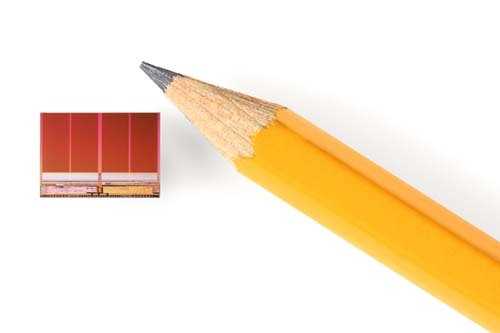The size of the USB stick is determined by the marketing people, the design department, and not necessarily the components inside it.
There are USB memory sticks that hold gigabytes of data that fit completely inside the USB port they are plugged into.
For a good example of just how small a thing large amounts of data can fit into, look at Micro-SD cards, which are used in many cell phones. The package is less than a centimeter on a side, only a mm or so thick, and can hold up to 32GB of data.
Generally, higher density components are more expensive. So a normal size USB memory stick doesn't have to use the most expensive, most dense components.
USB sticks are generally designed to fit comfortably within the hand and pocket. Smaller devices are more prone to getting lost, and larger devices won't fit in the pocket quite as well.
So in designing these devices, the company decides on a price point, which will govern to a certain extent how expensive the components can be, the design department decides on a branding and design and size, and then the technical people are told to make it work.

7You are equating "physically the same" with having "the same physical size". Two things that are the same size do not have to be physically the same! – David Schwartz – 2011-08-25T21:37:34.410
12Size matters not! Judge me by my size do you? – surfasb – 2011-08-26T02:59:31.143
1To quote Ron Gilbert on Twitter: “First hard drive I ever saw was 5MB and measured 3ft x 2ft. I just lost 8GB of storage in my couch cushions.” – Physical size does not mean anything :) – poke – 2011-08-26T10:32:59.947
6Want to really blow your mind? Sometimes different sized drives will have the same storage chips internally, but the smaller drive had a failure when tested at full capacity, so it was retested at the lower size and passed. This used to be much more common than it is today however. – Jim McKeeth – 2011-08-26T21:04:01.163
@Kit Ho: consider two people of the same size. one goes to the gym and does heavy lifting, while the other doesn't do any exercise. Which out of the two do you think will be more powerful? It's the same with 8GB and 16GB. Though they look the same, the 16GB is packed with more chips or a single more chip. Get it?? :D – None – 2011-08-26T07:59:20.813
That's a terrible analogy: Those two people are going to have physical differences. Or are you saying that body builders and your average "joe" have identical physical characteristics. Either way I make my 16GB drive work out everyday, if I'm lucky one day he'll make it to 32GB. – Supercereal – 2011-08-26T12:57:12.057
1-1 this is SUPER user, not electronics 101 – HaydnWVN – 2012-01-23T10:33:37.370